CHAPTER I
PREGNANCY
Although I was unable to observe pregnancy processes and the associated rites personally during my stay in 1973–1974, the thorough and unbiased accounts of four informants (G. Achaw, L. Amoak, R. Asekabta, and A. Akanbe) strongly agree. Therefore, the descriptions provided below should not deviate too much from the norm. However, given that all four informants are from the Wiaga, regional variations could still exist, particularly in Bulsaland’s southern villages and towns (Fumbisi, Kanjaga, etc.).
1. PROCREATION AND INFERTILITY
According to the Bulsa view, pregnancy only occurs through sexual intercourse, and a single instance of intercourse can be sufficient for impregnation. The old view is that the child is formed from the man’s sperm and the woman only gives the new being warmth and other necessary living conditions in her womb.
Children are conceived through intercourse between living people. Ancestral impregnation (kpilima puuk) is also possible, with the woman’s belly swelling as in a real pregnancy. However, ancestral pregnancy can never lead to childbirth. From a medical point of view, according to the nurse G. Achaw, this is probably due to abdominal dropsy (ascites).
In the past it was believed that, apart from impotence on the man’s part, only the woman could be infertile. Today, it could happen that {36} both spouses blame each other if the child blessing fails to materialise, despite having engaged in sexual intercourse.
If a woman does not bear children, her husband visits a diviner (baano, pl. baanoba). He may find out one of the following reasons:
1. There may be external reasons for the woman’s infertility (e.g., a hostile environment, unkind spirits or ancestors, witchcraft, or harmful spells). In these cases, the longed-for first birth can be brought about by defensive spells, punishing the guilty, a sacrifice, or the re-founding of a house.
2. The woman is physically infertile. In this case, nothing more can usually be done to bring about a birth, although some spouses may try to change fate through sacrifices to the ancestors or by certain other means. A woman will usually only believe in her own physical infertility when she has lived with several men without bearing any children, despite the husband’s proven fertility.
3. The wena [endnote 1] of the two spouses do not match. This also explains why infertile women change their spouses to find the right partner for their wen, although a woman may never be dismissed by her husband due to infertility.
If an infertile woman prefers to stay with her husband, she can have a girl (doglie) come from her kinship, who will later be given to her husband as a wife so that she may exercise a degree of supervision over the children of this girl herself [endnote 2].
If the failure to conceive is obviously due to the husband’s impotence, he may ask a classificatory brother to engage in intercourse with his wife. Although this behaviour is generally tolerated, it is nevertheless kabong, the worst form of adultery (see below), and the chicken ritual (kabong-fobka) must be performed at regular intervals. Later, the legal spouse is considered the father (pater) in a social sense.
Infertility is considered a disgrace, especially for women, and is accompanied by a loss of prestige. Even women who have attended school often perceive childlessness as an unbearable disgrace. A young woman living in Takoradi was ashamed for a long time to return to her home village of Sandema, as she was the only one among her former classmates without children. Although she loved her husband {37}and they had not quarrelled, she left him and married a man who already had many children by another woman. When she failed to conceive yet again, she left this man as well to live alone. She concludes her recorded life story with the following sentences:
… I [endnote 3] all the time talk to them [her friends] to help me, how I may get a child. Some of them say I should try to stay with a different tribe and see what will come. Since I don’t have a child, I think my future may be miserable, because when I grow old, I may have no one to help me … Because of this, I don’t visit my schoolmates, who were my friends in school. At this present time, I only think about how I will get a man who can get me pregnant to have a child in the future.
The narrator fails to mention that infertile women are often blamed for misfortunes in the house, especially when their husband’s other wives have children, and they are easily accused of witchcraft, as they allegedly want to harm the luckier women out of envy.
According to M. Arnheim from Gbedema, the corpse of a childless woman is carried out through the back wall of the compound for the noai-boka ritual (va nanggaang jo, “to pass through the nanggaang”). The wall must be knocked down at a certain point for this purpose (nag parik jo, “to knock down the outer wall and pass”). After the noai-boka ritual, the body is carried back into the compound through the main entrance. The hole in the back wall is immediately closed up.
2. PREGNANCY OF UNMARRIED WOMEN
If an unmarried girl becomes pregnant, she is quickly provided with a husband, who she marries before the child is born. In the polygamous traditional system of the Bulsa, premarital births are probably quite rare, and it is not difficult to find husbands for pregnant girls.
In recent times, with a large proportion of all children attending school, new potential complications have arisen. Pregnant schoolgirls usually leave school and parents are often enraged about such a pregnancy, after doing without their daughter’s household help for a significant amount of time during her school years and perhaps after abandoning plans for a modern career for her.
After marriage, no distinctions are made concerning legal, economic, and religious views between the father’s natural children and a child of the pregnant bride. The premarital male child can later make sacrifices to the ancestor of his mother’s husband, and he can become head of the compound (yeri-nyono) and inherit without any restrictions {38}. If the pregnant woman has married into a chieftain’s household, her son can even become chief.
When a mother gives birth to a child, before she has married a man, the child remains with the young mother’s parents and is also cared for by them. This also removes any legal claims of the child’s father (genitor). If the mother marries, the child usually remains in the mother’s parental home, as I know of in some cases. However, the possibility exists that the new husband “adopts” the child as his own. I was unable to obtain very clear information about the legal status of a child whose genitor is not the mother’s husband. Often the “pater” (against his better knowledge) also claims to be the “genitor”. In this case, the child enjoys the full rights of a legitimate child. In practice, children conceived and born premaritally (outside the mother’s new husband’s compound) do not have the same status and esteem as those conceived in wedlock, and they are sometimes subject to the ridicule of their half-siblings, especially during disputes.
3. RECOGNITION AND PROCLAMATION OF (THE FIRST) PREGNANCY
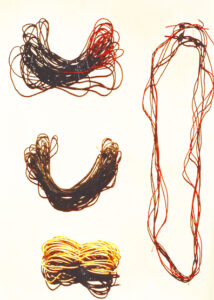
Different-coloured braided waist strings
Bulsa women are familiar with the usual symptoms indicating the start of pregnancy, such as the absence of menses, morning sickness, dizziness, swelling of the breasts and abdomen, darkening of the nipples, and changes in appetite and eating habits. Only when menstrual periods cease for three months does the husband notify some experienced women, who examine the woman thought to be pregnant. They communicate the results to the husband but not to the woman herself. The woman may also be sent to her own parental home by her husband’s mother under some pretext, or it is left to the women of her husband’s compound to determine the pregnancy. If pregnancy is suspected, the husband (other information indicates this may also be the father of the husband) visits the diviner. He finds the answers to the following questions:
1. Is the woman really pregnant?
2. Which woman should perform the ritual of pouring water (poi-nyatika or logi nyatika, endnote 4) if this is her first pregnancy? {39}
3. Does the pregnant woman have to observe any special taboos?
Once the husband has returned home, he offers millet water to his ancestors and informs the husband of the woman who is to perform the water-pouring ritual (poi-nyatika). Then, they fix the exact date of the ritual. The woman notified is always from the lineage of the pregnant woman’s husband, usually a sister (or, more rarely, a niece) of that husband [endnote 5]. She must be married herself and live outside her parents’ compound. The pregnant woman must not know the results of the divination visit or the negotiations with her relatives.
On the eve of the appointed day, the husband’s sister arrives at a late hour, often around midnight, and hides from the pregnant woman. She has already obtained the necessary red-and-black waist and neck laces and a black calabash [endnote 6], which must never have been used before. Often, the “sister” draws some water from a river that does not dry up even in the dry season on her way to the compound. She is allowed to scoop only once, even if she notices afterwards there is too much or too little water. On her way to the pregnant woman’s compound, she must not spill a drop of water, as that would indicate (or cause) a miscarriage. She puts some leaves (cham-vaata) from a young shea butter tree (Butyrospermum parkii) on top of the water. She may be met at the compound entrance by the pregnant woman’s husband, who shows her where the pregnant woman is sleeping. Some informants report that the husband is initiated, but he is usually already lying next to his wife when his sister arrives at night. No one else is allowed to be present during this ritual.
The “sister” walks towards their sleeping place and says three times, “Ma yaaka ni miena” (I love you all). According to the isolated statement of an informant from Sandema-Kobdem, she says, “N nyati fu puuka” (I announce your pregnancy). Then she quickly pours the water from the calabash in three parts on the sleeping woman [endnote 7], throws the empty black calabash on her, and tries to escape quickly, because if she is seen by the pregnant woman, she (the “sister”) must die. According to information from R. Asekabta, {40} the lives of the pregnant woman and her husband are also endangered. The awakened wife feigns ignorance of the situation, insults the water-shaker and tries to catch her, although she has long since taken refuge in another part of the compound.
At dawn on the next day (according to L. Amoak, at 4.30 a.m.), the “sister” comes to the pregnant woman’s sleeping room (dok), knocks on the wall, and calls the name of the pregnant woman three times, with the following addition:
Nyin pielim, ate n pon fi zuku ate fu. Jinla de ate ku a cheng, fi ka nipok kpak yogla. (Come out so I can shave your head for you. Today you are an old woman.)
The pregnant woman is then led to the front of the compound to undergo the ponika (shaving) ritual.
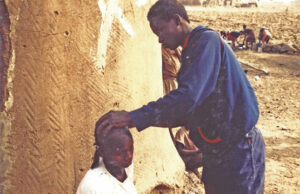
Ponika in front of the compound
A hairdresser, who has been sent for, shaves the woman’s head (completely, if she is pregnant for the first time) and the “sister” puts purple-black or black strings around her hips four times and a similar one around her neck [endnote 8]. Then, the pregnant woman is told she is pregnant, and anyone can mention her pregnancy in her presence. If one sees a woman with purple-black or black strings around her hips and neck, one can call her names and insult her very openly [endnote 9].
Millet porridge (T.Z.) and a guinea fowl are prepared for the water-shaker and the hairdresser. The “sister” takes the rest of the guinea fowl home with other gifts (e.g., millet) and the black calabash. The rest of the chicken is for her husband.
When Kenkenni (the wife of my assistant Danlardy Leander) became pregnant, she went with her mother-in-law, a guinea fowl, and a portion of millet porridge (saab) from her house in the centre of Wiaga to Adeween Yeri (or Asik Yeri), the traditional compound of her husband’s family in Badomsa. Although the couple usually slept in a modern bed, the following night they slept on a straw mat and were covered with only the free part of the mat. Earlier, they had ordered Adeweenlie, a daughter of Danlardy’s paternal uncle, to come to the compound. At night, when the couple had fallen asleep, she sprinkled water in which shea butter tree leaves were floating over Kenkenni four times and poured the rest of the water over her feet. The next morning, Kenkenni’s head was shaved completely bald, and Kenkenni and Adeweenlie shared the millet porridge they had brought with them. Kenkenni had to give Adeweenlie the clothes she was wearing at the time. The child that was born from this pregnancy also “belonged” to Adeweenlie.
It may happen that the relative designated for the water-pouring ritual is prevented from participating by illness or travel-related issues. She can then be replaced by another woman. A school graduate from Sandema-Kalijiisa had intended his pregnant wife’s poi-nyatika to be performed by the daughter of his father’s brother, who was also a school graduate and a Christian [endnote 10]. However, as she fell ill, her mother-in-law from Kobdem performed this ritual. All rights over the first-born child lay with the school graduate, who was aged about 25.
{41} Three days (for a boy) or four days (for a girl) after the birth of the first child, the water-shaker is informed about the birth by the young mother’s husband. She sends the woman in labour some salt, dawa-dawa, and a new calabash for the child to drink from later.
If the first-born child is a girl, she is sometimes sent as a doglie [endnote 11] to the water-shaker’s house at a very young age (but always after weaning). When the girl has grown up, she may be given to her aunt’s husband as a junior wife. If the first-born child is a boy, the father’s sister gives him a small wooden bow (biliok tom) with an arrow, which is supposed to be an indication that he will one day own a house. As soon as the boy can walk, he is given these weapons to play with. Today, the boy also may receive a piece of cloth as a gift. In return, he is later obliged to help his aunt when she asks.
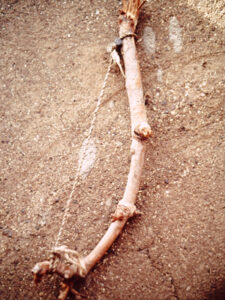
Bow (biliok-tom) on the wall
4. TABOOS, BANS, AND RULES OF CONDUCT
Immediately after the announcement of a pregnancy, the pregnant woman becomes subject to a wide range of prescriptions, which can only reservedly be called bans or taboos (kisita, sing. kisuk), as practitioners often only refer to them as medical precautions.
a) Food bans
The reason often given for the following food prohibitions is that eating these foods will make the unborn child too fat, which would make the birth more difficult. Other foods, such as “cold” things, can directly harm the child and the mother.
The following foods are forbidden for pregnant women:
fresh meat (dried meat is allowed);
fresh fish (dried fish is allowed);
eggs (The consumption of hen’s eggs {42} was forbidden to all women, at least in the past, and pregnant women are also forbidden to eat guinea fowl eggs.);
milk;
“cold” food or food from the previous day;
some vegetables (?); and
honey (After eating honey, the child’s nose will block the birth. Even after birth, the woman does not eat honey until the child has been weaned [endnote 12]).
Shortly before birth, the pregnant woman is not allowed to eat groundnuts or drink water that has not passed through an ash filter (katuak), thus acquiring a bitter taste [endnote 13]. This is why the Buli terms kaam or katuak are often translated as “vinegar”. The bitter water is used to prepare a soup called katuak for pregnant women; it contains green leaves, dawa-dawa, salt, and pepper. Together with millet porridge (saab, T.Z.), it is part of the main diet of pregnant women and those in labour. Katuak is also eaten by other people outside ritual occasions and is said to be a good remedy for stomach aches. However, before moving into a Bulsa compound, I was strongly advised by Christian missionaries not to eat this soup, as it is difficult for Europeans to digest.
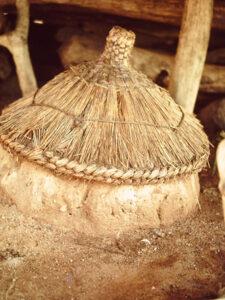
The tabooed ancestral shrine is covered with a woven storage lid (sampowuuk)
b) Prohibitions on seeing certain things and people
Immediately after the announcement of the pregnancy, the husband goes to his wife’s parents’ compound and asks his father-in-law to visit a diviner. According to other information, the husband or his father can also visit the diviner themselves to find out which living or deceased people the pregnant woman is not allowed to see. If the diviner discovers that the woman is not allowed to see the bogluk of one of her husband’s ancestors, something like a large straw cover (sampowuuk, pl. sampowuuta; e.g., a granary lid) is used for covering the ancestor’s bogluk (see photo). According to one informant, the taboo applies most often to the deceased great-grandfather of patrilineal {43} descent, and more rarely to the pregnant woman’s paternal grandfather, whose bogluk is in her parents’ compound. Another informant claims it is always the ancestor who is reborn in the child, but this information could not be corroborated by other reports.
In Asik Yeri (or Adeween Yeri), a daughter of the hosue who had outmarried was not allowed to see the ancestral shrine of Adeween (i.e., her paternal great-grandfather) after her pregnancy. This taboo continued even after she had given birth to other children. When visiting her parents’ house, the shrine’s wen stone is covered (e.g., with some straw; see photo).
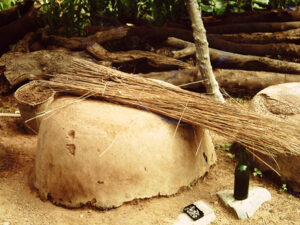
The tabooed ancestral shrine covered with straw
Among the living, the other wives of the pregnant woman’s husband are quite often subject to the prohibition of sight. Such a woman may return to her parental home for the duration of her co-wife’s pregnancy. If the tabooed person is a man, the pregnant woman will usually stay in her own quarters in the compound and will only leave these quarters through a back exit over the compound wall to relieve herself. If the pregnant woman is not allowed to see a person from her parents’ house, she will usually not visit this compound. Otherwise, it is quite common for the pregnant woman to spend more time in her parents’ house, even if the child will not be born there.
Since the unborn child is thought to look through the eyes of its mother, it is not clear whether the sight taboos discussed above apply only to the mother or also to the child. If the pregnant woman disregards one of these taboos, this can lead to her death or the death of her unborn child.
c) Rules of conduct for the pregnant woman
Although the woman carries out daily tasks until shortly before birth, she is advised to relax physically (e.g., not to run or dance), as this can lead to premature birth. She should keep her knees extended as much as possible. Therefore, she must not sit on a chair too often, but sit on the floor with her legs apart. At night, she must only sleep on her right or left side, not on her stomach or back. Maternity ward counsellors also forbid the wearing of high heels. Sexual intercourse with her husband until the seventh or eighth month is not only allowed, but even recommended, as this leads to an easy birth.
The pregnant woman is not allowed to walk over any blood or help with any birth. She may attend funeral services, but may not distribute any gifts there [endnote 14].
{44} When her abdomen is swollen, she should pound at the mortar frequently, as this is considered a kind of gymnastics.
d) Prohibitions for the spouse
The pregnant woman’s spouse must comply with certain regulations during the pregnancy:
1. He may not kill certain wild animals while hunting. R. Schott’s unpublished field notes list the following wild animals covered by this prohibition: bush cow or buffalo, pig, lion, and leopard. If the husband of a pregnant woman kills such an animal, he tries to place the “blame” on another hunter. Otherwise, the child will die at birth [endnote 15].
2. The husband must not build a new mud hut. If this regulation is not respected, his wife will die during childbirth [endnote 16].
3. He must not distribute presents at funeral ceremonies.
4. He must not give presents to his wife’s parents. This includes payments connected with the marriage, such as the “closing of the gate” (nansiung-lika). According to R. Schott [endnote 17], if the husband “closed the gate” during his wife’s pregnancy, he would close the child in her womb.
5. He must not do any work in his wife’s parental compound.
The husband’s taboos are automatically lifted through the ritual “outdooring” of his wife after childbirth. Some of these prohibitions and regulations can be explained by the pregnant woman’s interim status. In the case of payments (e.g., for nansiung-lika), it is not certain whether they are to be made for a wife who is childless or for a mother. This dilemma is neutralised by forbidding all payments when a woman is in this state.
5. PREGNANCY RITUALS AFTER FREQUENT MISCARRIAGES
If a pregnant woman has suffered several miscarriages, the same woman who performed the poi-nyatika ritual during the first pregnancy returns to the compound. After the pregnancy has been proven, this woman puts an undyed waist string around the pregnant woman’s hips. The ritual of pouring water is omitted at this time.
If a daughter is born later, she also wears an undyed waist string {45} for a period of time, sometimes until she is circumcised. She is perhaps even more attached to her father’s sister than a girl born after a first pregnancy. If she does not want to marry her father’s sister’s husband or the man chosen by her father’s sister, she can return to her parents, but she must be in her aunt’s house during her own pregnancy {46}.
ENDNOTES
(CHAPTER 1: PREGNANCY)
1 On the term wen: See the list of some Buli terms in the appendix {392}.
If the two spouses’ wena do not agree (wena kan siagi) or do not get along, conflicts, diseases, misfortunes, and others can force the married partners to separate.
2 The girl takes the position of a doglie. Cf. List of some Buli terms, p. {388}. This institution (doglientiri) has been described and analysed in detail by B. Meier (1992, 1997 and 1999).
3 The spelling has been corrected in the English quotations from Bulsa life stories. Erroneous expressions have been retained as far as the sentence is understandable. Otherwise, corrections or explanations are given in brackets. Some information from these life stories was published in Kröger (1997).
4 Nyati: 1. recognise, 2. proclaim. The root nya means “to see”; poi means 1. belly, 2. pregnancy (synonymous with puuk?).
5 As FZ (father’s sister), this woman carries the kinship designation ko (classificatory “father”).
6 According to information from Gbedema, it should be a knobbed calabash.
7 Pouring water three times in a ceremony in which only women participate is unexpected, as four is usually considered a “female number” (male = 3). According to other information, water is poured four times.
8 The colours of these and other waist strings apparently vary from place to place. Women often buy undyed strings and dye them for each special purpose.
9 Although this behaviour towards the first-time pregnant woman is reminiscent of joking relationships (Buli: ale chaab leka or gbiera), several informants do not refer to it as a “joking relationship”, since such behaviour is displayed only for a limited time.
10 This was allegedly done without consulting diviners.
11 Domestic helper of a married woman from her own lineage. A doglie is expected later to marry the spouse of the older relatives. Cf. p. 258 f.
12 Information from R. Schott, Unpublished Field Notes 1966/67.
13 The water runs from a clay pot filled with the ashes of burnt millet stalks into a second clay pot through a small hole in the base. Cf. ethnographic collection of F. Kröger in the museum Forum der Völker, Werl, and Kröger 2001: 210-11.
14 Information from R. Schott, Unpublished Field Notes 1966/67, p. 219 f.
15 Ibid. p. 219f.
16 Ibid.
17 Ibid. p. 21: “…otherwise you have closed the child inside the woman’s stomach”.
- Title, Contents and Preface
- Introduction
- Chapter I: Pregnancy
- Chapter II: Birth
- Chapter III: The Guardian Spirit, Naming and Names
- Chapter IV: Scarifications
- Chapter V: Wen Rites
- Chapter VI: Excision and Circumcision
- Chapter VII: Courting and Marriage
- Chapter VIII: Death and Burial
- Chapter VIII (contd.): Funeral Celebrations
- Conclusion
- Appendix